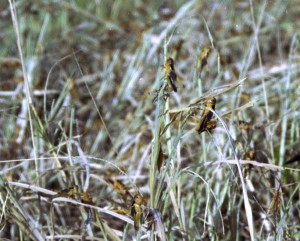Locusts on the move in Queensland
January 14th, 2015
 There are over 500 known grasshopper species across Australia. Within Queensland, four of these species are recognised as having economic importance, largely due to their potential to form destructive swarms.
There are over 500 known grasshopper species across Australia. Within Queensland, four of these species are recognised as having economic importance, largely due to their potential to form destructive swarms.
These are the:
- Australian plague locust (Chortoicetes terminifera)
- migratory locust (Locusta migratoria)
- spur-throated locust (Austracris guttulosa) and
- yellow-winged locust (Gastrimargus musicus).
The first three of these species are considered Class 2 declared species under the Land Protection (Pest and Stock Route Management) Act 2002. The yellow-winged locust is not declared.
Locust plagues are closely monitored by the APLC
The Australian Plague Locust Commission (APLC) works in conjunction with state biosecurity authorities to monitor locust activity across the country. Biosecurity Queensland is responsible for coordinating any widespread swarm control efforts across Queensland, whilst APLC manages swarms that have the potential to significantly impact on agricultural activities across more than one state.
As for most other pest species, landholders are required to take steps to control numbers on their property and protect their own crops and pastures from damage as required. The best time to control these species is at the nymphal stage whilst banding once they get on the wing they are extremely difficult to manage without significant resources. There are a number of control options available to landholders to control the nymphs.
The latest Locust Bulletin suggests that December saw some localised swarm and egg laying activities throughout south west and central Queensland. Habitat conditions are favourable for nymph survival in some regions and the APLC forecasts more localised nymph bands across central west Queensland and central west New South Wales. It also notes that swarm formation is likely in these regions during February with a widespread infestation possible in South Central Queensland. The risk of migrations to other regions will increase in February.
What to do about locusts
Land owners and managers are encouraged to maintain vigilance.
It is also important to report any locust activity as soon as possible to either:
- Biosecurity Queensland on 13 25 23 or your local Biosecurity Officer for your area or
- The Australian Plague Locust Commission on 1800 635 962.
You can access further information on the Locust Bulletins page of the Department of Agriculture website.